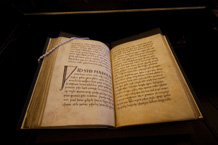Riddle
Riddles are a form of puzzle or problem that are typically presented in the form of a question, statement, or phrase which requires ingenuity in ascertaining its answer or meaning. Often, riddles come in the form of a poem, a question, or a puzzle that requires the solver to think outside the box and apply lateral thinking skills. Riddles have been a part of human culture since ancient times, serving not only as a means of entertainment but also as tools for education, passing down traditions, and even as a method to convey moral or philosophical messages.
Types of Riddles[edit | edit source]
Riddles can generally be classified into two main types: enigmas and conundrums.
- Enigmas are riddles that are expressed in metaphorical or allegorical language, requiring careful thinking and ingenuity to solve. They often involve a broad range of thought, including analogy, metaphor, and extensive use of symbolism.
- Conundrums are riddles that pose a question or statement that has a pun or play on words as its answer. These are often used as a form of wordplay or to induce humor.
History[edit | edit source]
The history of riddles dates back to ancient civilizations, including the Sumerians, who are credited with some of the earliest known riddles. Ancient Greek literature, such as Homer's The Odyssey, contains riddles that characters use to test each other's wit and intelligence. In the Middle Ages, riddles were popular among all classes of society and were often featured in folk tales and literature.
Cultural Significance[edit | edit source]
Riddles have played a significant role in various cultures around the world. In some cultures, riddles were used as a form of oral tradition to pass down knowledge, history, and values from one generation to the next. They have also been used as educational tools to encourage critical thinking and problem-solving skills.
Examples[edit | edit source]
One of the most famous examples of a riddle is the Riddle of the Sphinx, a mythological story from ancient Egypt and Greece. The Sphinx posed a riddle to travelers, and those who could not answer were killed. The riddle was: "What walks on four legs in the morning, two legs at noon, and three legs in the evening?" The answer is "man," who crawls on all fours as a baby, walks on two legs as an adult, and uses a cane in old age.
In Literature[edit | edit source]
Riddles have been featured prominently in literature throughout history. In The Hobbit by J.R.R. Tolkien, riddles are used as a form of contest between Bilbo Baggins and Gollum. William Shakespeare also used riddles in his plays to convey messages or challenge characters.
Modern Usage[edit | edit source]
Today, riddles are still popular, often found in puzzle books, educational materials, and on the internet. They are used not only for entertainment but also as exercises to stimulate cognitive abilities and promote creative thinking.
| This article is a stub. You can help WikiMD by registering to expand it. |
Search WikiMD
Ad.Tired of being Overweight? Try W8MD's NYC physician weight loss.
Semaglutide (Ozempic / Wegovy and Tirzepatide (Mounjaro / Zepbound) available. Call 718 946 5500.
Advertise on WikiMD
|
WikiMD's Wellness Encyclopedia |
| Let Food Be Thy Medicine Medicine Thy Food - Hippocrates |
Translate this page: - East Asian
中文,
日本,
한국어,
South Asian
हिन्दी,
தமிழ்,
తెలుగు,
Urdu,
ಕನ್ನಡ,
Southeast Asian
Indonesian,
Vietnamese,
Thai,
မြန်မာဘာသာ,
বাংলা
European
español,
Deutsch,
français,
Greek,
português do Brasil,
polski,
română,
русский,
Nederlands,
norsk,
svenska,
suomi,
Italian
Middle Eastern & African
عربى,
Turkish,
Persian,
Hebrew,
Afrikaans,
isiZulu,
Kiswahili,
Other
Bulgarian,
Hungarian,
Czech,
Swedish,
മലയാളം,
मराठी,
ਪੰਜਾਬੀ,
ગુજરાતી,
Portuguese,
Ukrainian
Medical Disclaimer: WikiMD is not a substitute for professional medical advice. The information on WikiMD is provided as an information resource only, may be incorrect, outdated or misleading, and is not to be used or relied on for any diagnostic or treatment purposes. Please consult your health care provider before making any healthcare decisions or for guidance about a specific medical condition. WikiMD expressly disclaims responsibility, and shall have no liability, for any damages, loss, injury, or liability whatsoever suffered as a result of your reliance on the information contained in this site. By visiting this site you agree to the foregoing terms and conditions, which may from time to time be changed or supplemented by WikiMD. If you do not agree to the foregoing terms and conditions, you should not enter or use this site. See full disclaimer.
Credits:Most images are courtesy of Wikimedia commons, and templates, categories Wikipedia, licensed under CC BY SA or similar.
Contributors: Prab R. Tumpati, MD




